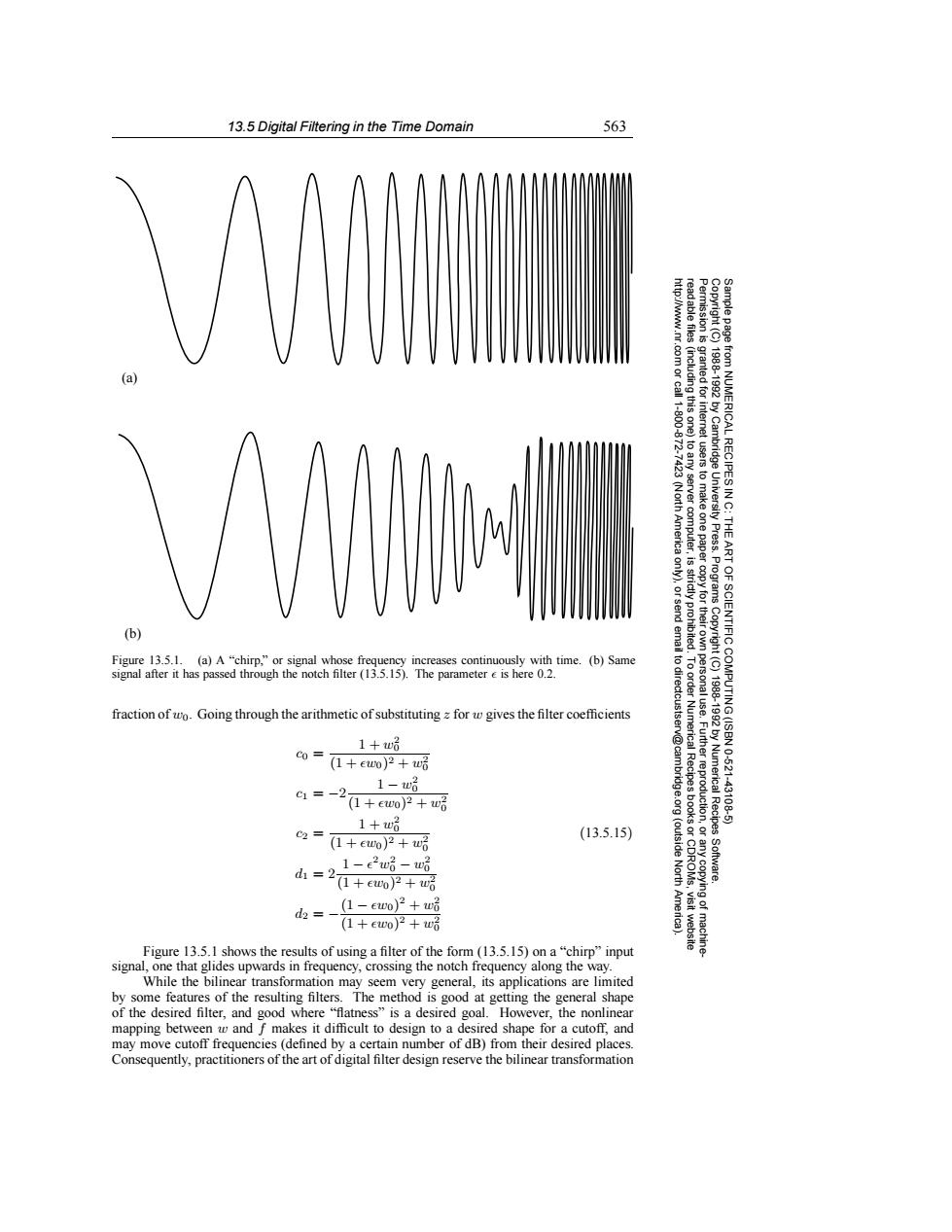正在加载图片...

13.5 Digital Filtering in the Time Domain 563 .com or call 1-800-872- (including this one) granted for i internet 州pWer:s to -7423(North America tusers to make one paper from NUMERICAL RECIPES IN C: 1988-1992 by Cambridge University Press.Programs THE 是 (b) Figure 13.5.1.(a)A"chirp,"or signal whose frequency increases continuously with time.(b)Same signal after it has passed through the notch filter (13.5.15).The parameter e is here 0.2. to dir 18818920 ART OF SCIENTIFIC COMPUTING (ISBN fraction of wo.Going through the arithmetic of substituting z for w gives the filter coefficients 1+w后 C0= (1+e0)2+6 10-521 1-w6 C1=-2 1+ewo)2+哈 Numerical Recipes 43106 1+w哈 C2= (1+eo)2+u哈 (13.5.15) (outside 1-e2w哈-w哈 d1=2 Software. (1+euo)尸+u哈 d2= (1-eo)2+w6 (1+eo)2+哈 Figure 13.5.1 shows the results of using a filter of the form (13.5.15)on a"chirp"input signal,one that glides upwards in frequency,crossing the notch frequency along the way. While the bilinear transformation may seem very general,its applications are limited by some features of the resulting filters.The method is good at getting the general shape of the desired filter,and good where "flatness"is a desired goal.However,the nonlinear mapping between w and f makes it difficult to design to a desired shape for a cutoff,and may move cutoff frequencies(defined by a certain number of dB)from their desired places. Consequently,practitioners of the art of digital filter design reserve the bilinear transformation13.5 Digital Filtering in the Time Domain 563 Permission is granted for internet users to make one paper copy for their own personal use. Further reproduction, or any copyin Copyright (C) 1988-1992 by Cambridge University Press. Programs Copyright (C) 1988-1992 by Numerical Recipes Software. Sample page from NUMERICAL RECIPES IN C: THE ART OF SCIENTIFIC COMPUTING (ISBN 0-521-43108-5) g of machinereadable files (including this one) to any server computer, is strictly prohibited. To order Numerical Recipes books or CDROMs, visit website http://www.nr.com or call 1-800-872-7423 (North America only), or send email to directcustserv@cambridge.org (outside North America). (a) (b) Figure 13.5.1. (a) A “chirp,” or signal whose frequency increases continuously with time. (b) Same signal after it has passed through the notch filter (13.5.15). The parameter is here 0.2. fraction of w0. Going through the arithmetic of substituting z for w gives the filter coefficients c0 = 1 + w2 0 (1 + w0)2 + w2 0 c1 = −2 1 − w2 0 (1 + w0)2 + w2 0 c2 = 1 + w2 0 (1 + w0)2 + w2 0 d1 = 2 1 − 2w2 0 − w2 0 (1 + w0)2 + w2 0 d2 = −(1 − w0) 2 + w2 0 (1 + w0)2 + w2 0 (13.5.15) Figure 13.5.1 shows the results of using a filter of the form (13.5.15) on a “chirp” input signal, one that glides upwards in frequency, crossing the notch frequency along the way. While the bilinear transformation may seem very general, its applications are limited by some features of the resulting filters. The method is good at getting the general shape of the desired filter, and good where “flatness” is a desired goal. However, the nonlinear mapping between w and f makes it difficult to design to a desired shape for a cutoff, and may move cutoff frequencies (defined by a certain number of dB) from their desired places. Consequently, practitioners of the art of digital filter design reserve the bilinear transformation